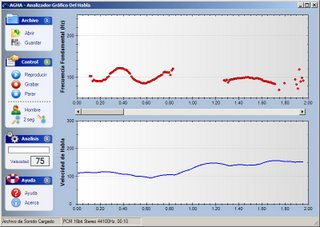 Phew, I'm starting to finish off some side projects. Yesterday I made the finishing touches on a speech analyzer program meant as an accompanying tool for a set of oratory courses in Spanish. It's programmed in .NET and makes some beautiful real-time plots of voice frequency (pitch) and speech rate. Some technical details: real-time pitch estimation was done by Noll's algorithm, real-time speech rate estimation was a mix between enrate and a newer correlation-based method. For the signal processing part we relied on the Exocortex.DSP FFT library, and for the graphics we used the ZedGraph classes.
Phew, I'm starting to finish off some side projects. Yesterday I made the finishing touches on a speech analyzer program meant as an accompanying tool for a set of oratory courses in Spanish. It's programmed in .NET and makes some beautiful real-time plots of voice frequency (pitch) and speech rate. Some technical details: real-time pitch estimation was done by Noll's algorithm, real-time speech rate estimation was a mix between enrate and a newer correlation-based method. For the signal processing part we relied on the Exocortex.DSP FFT library, and for the graphics we used the ZedGraph classes.Good. One for the archive.
2 comments:
I am trying to use Exocortex to extract the pitch (fundamental frequency) of a wav file. The wav sample is just a single tone. I am able to create a Complex array and FFT it, but how to determine pitch from the FFT'd array? Numerical Recipes in C hinted that you find the maximum absolute value of the array and the index is the pitch:
Exocortex.DSP.Fourier.FFT(cf, Exocortex.DSP.FourierDirection.Forward);
int fundamental_frequency = 0;
for (int i = 0; i < 1024; i++)
{
if ((Math.Pow(cf[i].Re, 2) + Math.Pow(cf[i].Im, 2)) > (Math.Pow(cf[fundamental_frequency].Re, 2) + Math.Pow(cf[fundamental_frequency].Im, 2)))
{
fundamental_frequency = i;
}
}
textBox1.Text += fundamental_frequency.ToString();
But these results dont make much scense.
Tnx for any help with this.
jpreston12 at hotmail.com
jeff
Hi Jeff,
I closed this project a few years ago, and I don't recall exactly what coefficients the FFT function returns. But supposing it is just an array of Fourier coefficients of length N/2, then you get the fundamental frequency by taking into account that index i in your array corresponds to frequency 2*(i-1)/fs, where fs is your sampling frequency.
If it still doesn't make sense, try plotting the entire array of absolute values of cf for a simple signal (i.e. a sine wave). You should see a very distinctive peak in the diagram.
Post a Comment